HI6028 Taxation: Capital Gains Tax and GST Assignment, T2 2019
VerifiedAdded on 2022/10/14
|6
|2456
|12
Assignment
AI Summary
This document presents a comprehensive solution to an HI6028 Taxation assignment, focusing on the application of Capital Gains Tax (CGT) and Goods and Services Tax (GST) principles within the Australian context. The assignment analyzes two distinct scenarios: the first examines the GST implications for a property development and investment company, specifically regarding input tax credits for vacant land and professional services, and the second evaluates the CGT implications of various asset sales, including land, stamps, shares, and a grand piano. The solution meticulously calculates capital gains and losses, considering relevant costs, expenses, and tax exemptions, while referencing pertinent sections of the Income Tax Assessment Act 1997. The analysis provides detailed explanations and calculations, demonstrating a clear understanding of taxation laws and their practical application. The assignment covers various aspects such as the determination of the cost base, the impact of interest payments, and the application of exemptions for personal assets, offering a practical guide to tax compliance and planning.
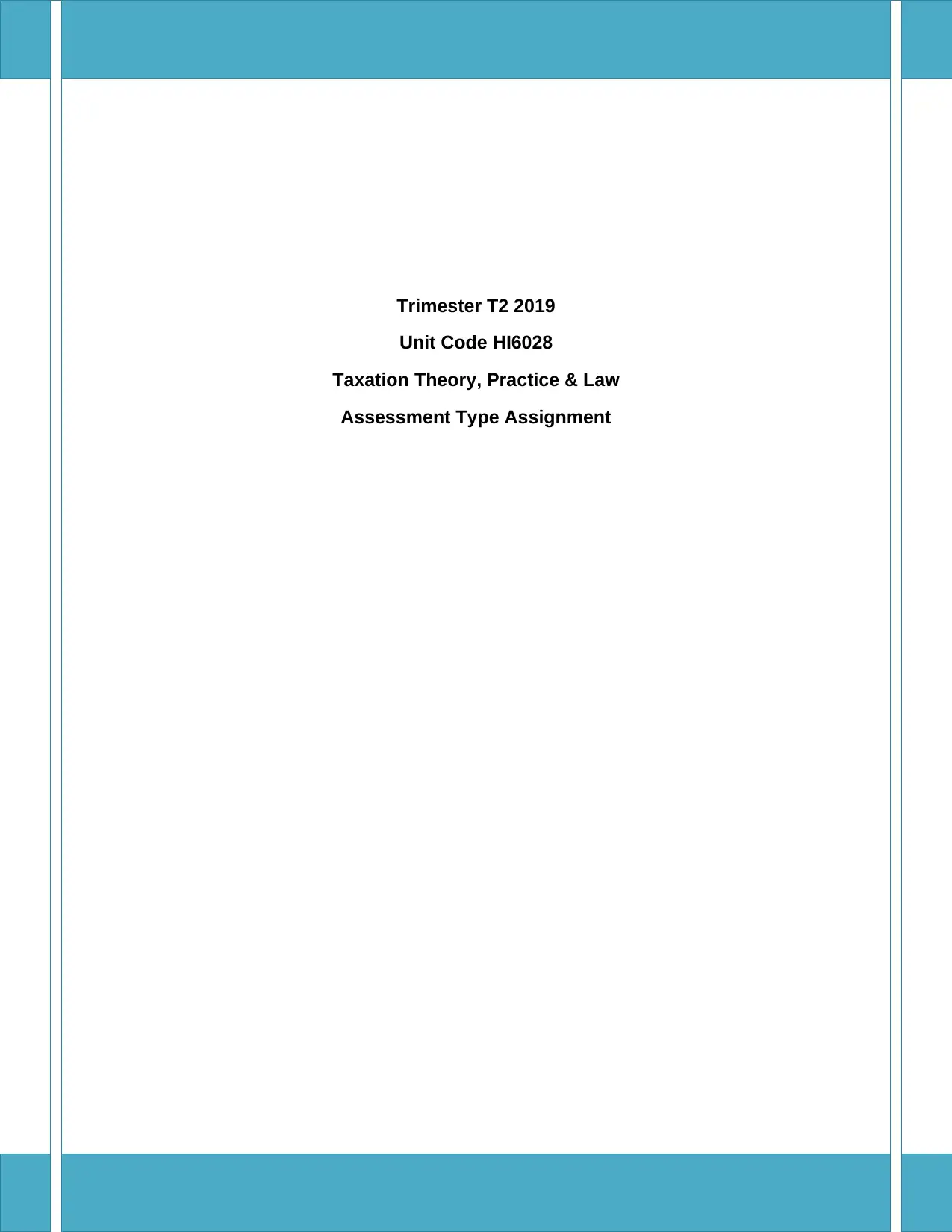
Trimester T2 2019
Unit Code HI6028
Taxation Theory, Practice & Law
Assessment Type Assignment
Unit Code HI6028
Taxation Theory, Practice & Law
Assessment Type Assignment
Paraphrase This Document
Need a fresh take? Get an instant paraphrase of this document with our AI Paraphraser

Taxation
Answer 1
A capital gain occurs when the sale of an asset surpasses the cost of acquisition while capital
loss is the reverse scenario that is the sale amount ranks lower as compared to the purchase
price. The concept of capital gain tax implies that the proceeds from the capital assets will be
subjected to tax. The proceeds that happen from the sale of different assets come under the
concept of GST but subjected to interpretations and certain exemptions (Bahari, 2019).
In the case study, the City Sky Company is into operations that pertain to the development
and investment industry and thereby not required to claim the input credit which is even
described as GST credit. As per Division 9 of the New Tax system of Australia when any raw
materials are purchased to produce a product and sell it, tax is paid on the material or input.
Hence, tax is needed to be paid on the finished output and the deduction of the tax that is
already paid on the inward materials needs to be adjusted to derive at the net tax liability.
When it comes to the concept of vacant land, it can be termed either residential or non-
residential property that is entirely dependent on the activity that is done on the land. If any
traces of residential activity have been done on the land then it will come under the ambit of
residential property (Camp, 2019). Vacant land that has been occupied by any person or
comprises the activity of owing then it will be deemed to have residential status (Gaal, 2019).
The vacant land that has been purchased by The City Sky Company cannot come under the
purview of GST. Hence, the company is not in a position to claim input tax credit because the
land does not come under the purview of the GST since there has been no residential activity
on the plot of land (Nethercott, Richardson & devos, 2013). An input tax credit that applies to
the raw material purchased by the company and supposed to be utilized in the residential
apartment on the newly purchased property can be left aside. Goods and service tax reversal
can be claimed when the services pertain to the expansion of the business. Therefore, it is a
clear consideration that the concept of reversal will happen when the services will pertain to
the activities of the business. Hence, under this information, it is clear that The City Sky
Company has ensured eligibility for the input tax credit on the payment of GST.
Further, the hiring of an advocate by the company so that the input tax credit becomes easier.
For the same an amount of $ 33,000 is paid. The invoiced amount can be claimed for the
input tax credit on GST because the services rendered by the lawyer come under the ambit of
development activities. Such services are not in direct connection with the development
activities thereby the company can claim the input tax credit (ATO, 2019). But, the company
cannot claim the input tax credit on material such as iron, TMT bars, cement, etc. the amount
that is earned by the lawyer subject to $300,000 but the threshold for registration under GST
stand at $75,000. This information does not make any impact because the company is in a
position to claim the input tax credit.
2
Answer 1
A capital gain occurs when the sale of an asset surpasses the cost of acquisition while capital
loss is the reverse scenario that is the sale amount ranks lower as compared to the purchase
price. The concept of capital gain tax implies that the proceeds from the capital assets will be
subjected to tax. The proceeds that happen from the sale of different assets come under the
concept of GST but subjected to interpretations and certain exemptions (Bahari, 2019).
In the case study, the City Sky Company is into operations that pertain to the development
and investment industry and thereby not required to claim the input credit which is even
described as GST credit. As per Division 9 of the New Tax system of Australia when any raw
materials are purchased to produce a product and sell it, tax is paid on the material or input.
Hence, tax is needed to be paid on the finished output and the deduction of the tax that is
already paid on the inward materials needs to be adjusted to derive at the net tax liability.
When it comes to the concept of vacant land, it can be termed either residential or non-
residential property that is entirely dependent on the activity that is done on the land. If any
traces of residential activity have been done on the land then it will come under the ambit of
residential property (Camp, 2019). Vacant land that has been occupied by any person or
comprises the activity of owing then it will be deemed to have residential status (Gaal, 2019).
The vacant land that has been purchased by The City Sky Company cannot come under the
purview of GST. Hence, the company is not in a position to claim input tax credit because the
land does not come under the purview of the GST since there has been no residential activity
on the plot of land (Nethercott, Richardson & devos, 2013). An input tax credit that applies to
the raw material purchased by the company and supposed to be utilized in the residential
apartment on the newly purchased property can be left aside. Goods and service tax reversal
can be claimed when the services pertain to the expansion of the business. Therefore, it is a
clear consideration that the concept of reversal will happen when the services will pertain to
the activities of the business. Hence, under this information, it is clear that The City Sky
Company has ensured eligibility for the input tax credit on the payment of GST.
Further, the hiring of an advocate by the company so that the input tax credit becomes easier.
For the same an amount of $ 33,000 is paid. The invoiced amount can be claimed for the
input tax credit on GST because the services rendered by the lawyer come under the ambit of
development activities. Such services are not in direct connection with the development
activities thereby the company can claim the input tax credit (ATO, 2019). But, the company
cannot claim the input tax credit on material such as iron, TMT bars, cement, etc. the amount
that is earned by the lawyer subject to $300,000 but the threshold for registration under GST
stand at $75,000. This information does not make any impact because the company is in a
position to claim the input tax credit.
2
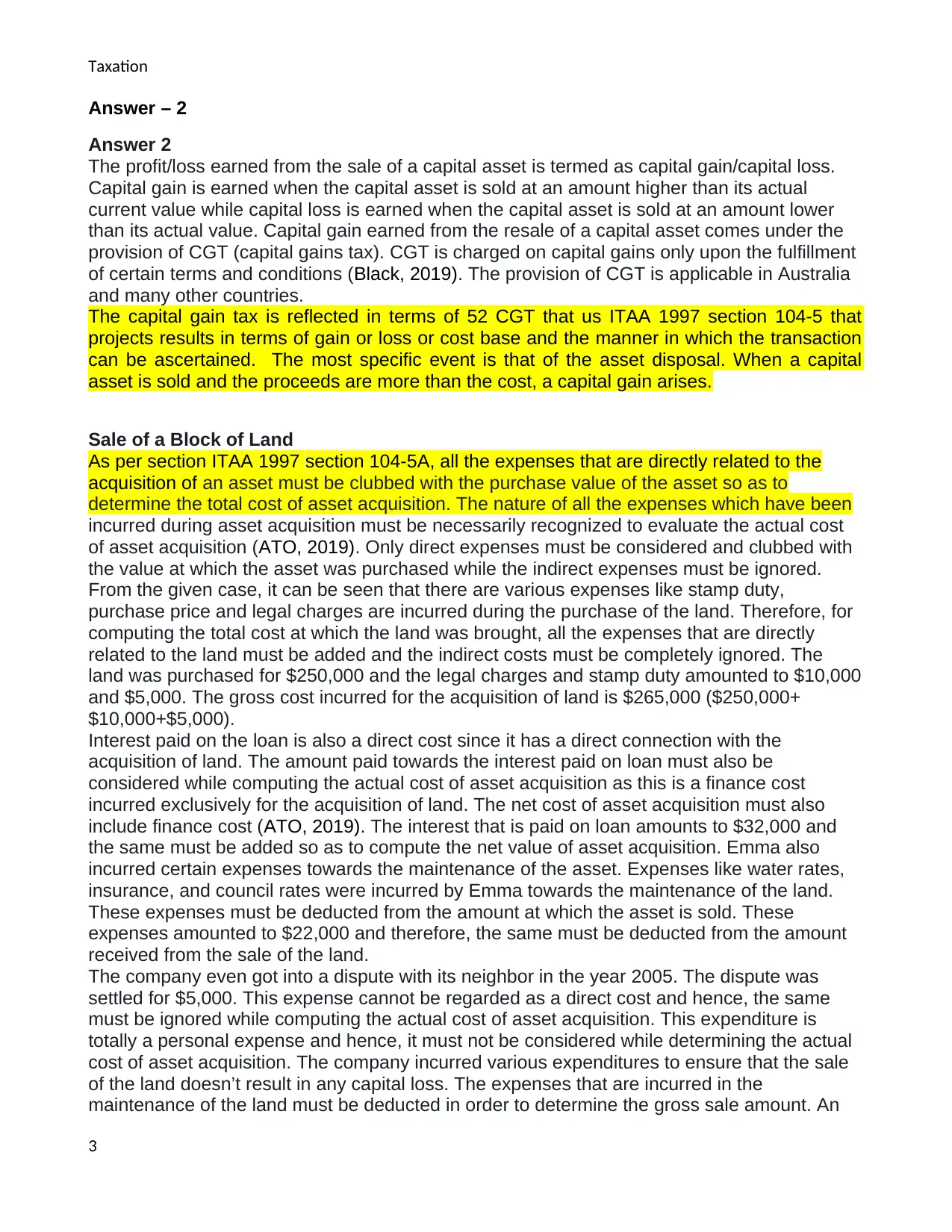
Taxation
Answer – 2
Answer 2
The profit/loss earned from the sale of a capital asset is termed as capital gain/capital loss.
Capital gain is earned when the capital asset is sold at an amount higher than its actual
current value while capital loss is earned when the capital asset is sold at an amount lower
than its actual value. Capital gain earned from the resale of a capital asset comes under the
provision of CGT (capital gains tax). CGT is charged on capital gains only upon the fulfillment
of certain terms and conditions (Black, 2019). The provision of CGT is applicable in Australia
and many other countries.
The capital gain tax is reflected in terms of 52 CGT that us ITAA 1997 section 104-5 that
projects results in terms of gain or loss or cost base and the manner in which the transaction
can be ascertained. The most specific event is that of the asset disposal. When a capital
asset is sold and the proceeds are more than the cost, a capital gain arises.
Sale of a Block of Land
As per section ITAA 1997 section 104-5A, all the expenses that are directly related to the
acquisition of an asset must be clubbed with the purchase value of the asset so as to
determine the total cost of asset acquisition. The nature of all the expenses which have been
incurred during asset acquisition must be necessarily recognized to evaluate the actual cost
of asset acquisition (ATO, 2019). Only direct expenses must be considered and clubbed with
the value at which the asset was purchased while the indirect expenses must be ignored.
From the given case, it can be seen that there are various expenses like stamp duty,
purchase price and legal charges are incurred during the purchase of the land. Therefore, for
computing the total cost at which the land was brought, all the expenses that are directly
related to the land must be added and the indirect costs must be completely ignored. The
land was purchased for $250,000 and the legal charges and stamp duty amounted to $10,000
and $5,000. The gross cost incurred for the acquisition of land is $265,000 ($250,000+
$10,000+$5,000).
Interest paid on the loan is also a direct cost since it has a direct connection with the
acquisition of land. The amount paid towards the interest paid on loan must also be
considered while computing the actual cost of asset acquisition as this is a finance cost
incurred exclusively for the acquisition of land. The net cost of asset acquisition must also
include finance cost (ATO, 2019). The interest that is paid on loan amounts to $32,000 and
the same must be added so as to compute the net value of asset acquisition. Emma also
incurred certain expenses towards the maintenance of the asset. Expenses like water rates,
insurance, and council rates were incurred by Emma towards the maintenance of the land.
These expenses must be deducted from the amount at which the asset is sold. These
expenses amounted to $22,000 and therefore, the same must be deducted from the amount
received from the sale of the land.
The company even got into a dispute with its neighbor in the year 2005. The dispute was
settled for $5,000. This expense cannot be regarded as a direct cost and hence, the same
must be ignored while computing the actual cost of asset acquisition. This expenditure is
totally a personal expense and hence, it must not be considered while determining the actual
cost of asset acquisition. The company incurred various expenditures to ensure that the sale
of the land doesn’t result in any capital loss. The expenses that are incurred in the
maintenance of the land must be deducted in order to determine the gross sale amount. An
3
Answer – 2
Answer 2
The profit/loss earned from the sale of a capital asset is termed as capital gain/capital loss.
Capital gain is earned when the capital asset is sold at an amount higher than its actual
current value while capital loss is earned when the capital asset is sold at an amount lower
than its actual value. Capital gain earned from the resale of a capital asset comes under the
provision of CGT (capital gains tax). CGT is charged on capital gains only upon the fulfillment
of certain terms and conditions (Black, 2019). The provision of CGT is applicable in Australia
and many other countries.
The capital gain tax is reflected in terms of 52 CGT that us ITAA 1997 section 104-5 that
projects results in terms of gain or loss or cost base and the manner in which the transaction
can be ascertained. The most specific event is that of the asset disposal. When a capital
asset is sold and the proceeds are more than the cost, a capital gain arises.
Sale of a Block of Land
As per section ITAA 1997 section 104-5A, all the expenses that are directly related to the
acquisition of an asset must be clubbed with the purchase value of the asset so as to
determine the total cost of asset acquisition. The nature of all the expenses which have been
incurred during asset acquisition must be necessarily recognized to evaluate the actual cost
of asset acquisition (ATO, 2019). Only direct expenses must be considered and clubbed with
the value at which the asset was purchased while the indirect expenses must be ignored.
From the given case, it can be seen that there are various expenses like stamp duty,
purchase price and legal charges are incurred during the purchase of the land. Therefore, for
computing the total cost at which the land was brought, all the expenses that are directly
related to the land must be added and the indirect costs must be completely ignored. The
land was purchased for $250,000 and the legal charges and stamp duty amounted to $10,000
and $5,000. The gross cost incurred for the acquisition of land is $265,000 ($250,000+
$10,000+$5,000).
Interest paid on the loan is also a direct cost since it has a direct connection with the
acquisition of land. The amount paid towards the interest paid on loan must also be
considered while computing the actual cost of asset acquisition as this is a finance cost
incurred exclusively for the acquisition of land. The net cost of asset acquisition must also
include finance cost (ATO, 2019). The interest that is paid on loan amounts to $32,000 and
the same must be added so as to compute the net value of asset acquisition. Emma also
incurred certain expenses towards the maintenance of the asset. Expenses like water rates,
insurance, and council rates were incurred by Emma towards the maintenance of the land.
These expenses must be deducted from the amount at which the asset is sold. These
expenses amounted to $22,000 and therefore, the same must be deducted from the amount
received from the sale of the land.
The company even got into a dispute with its neighbor in the year 2005. The dispute was
settled for $5,000. This expense cannot be regarded as a direct cost and hence, the same
must be ignored while computing the actual cost of asset acquisition. This expenditure is
totally a personal expense and hence, it must not be considered while determining the actual
cost of asset acquisition. The company incurred various expenditures to ensure that the sale
of the land doesn’t result in any capital loss. The expenses that are incurred in the
maintenance of the land must be deducted in order to determine the gross sale amount. An
3
⊘ This is a preview!⊘
Do you want full access?
Subscribe today to unlock all pages.

Trusted by 1+ million students worldwide
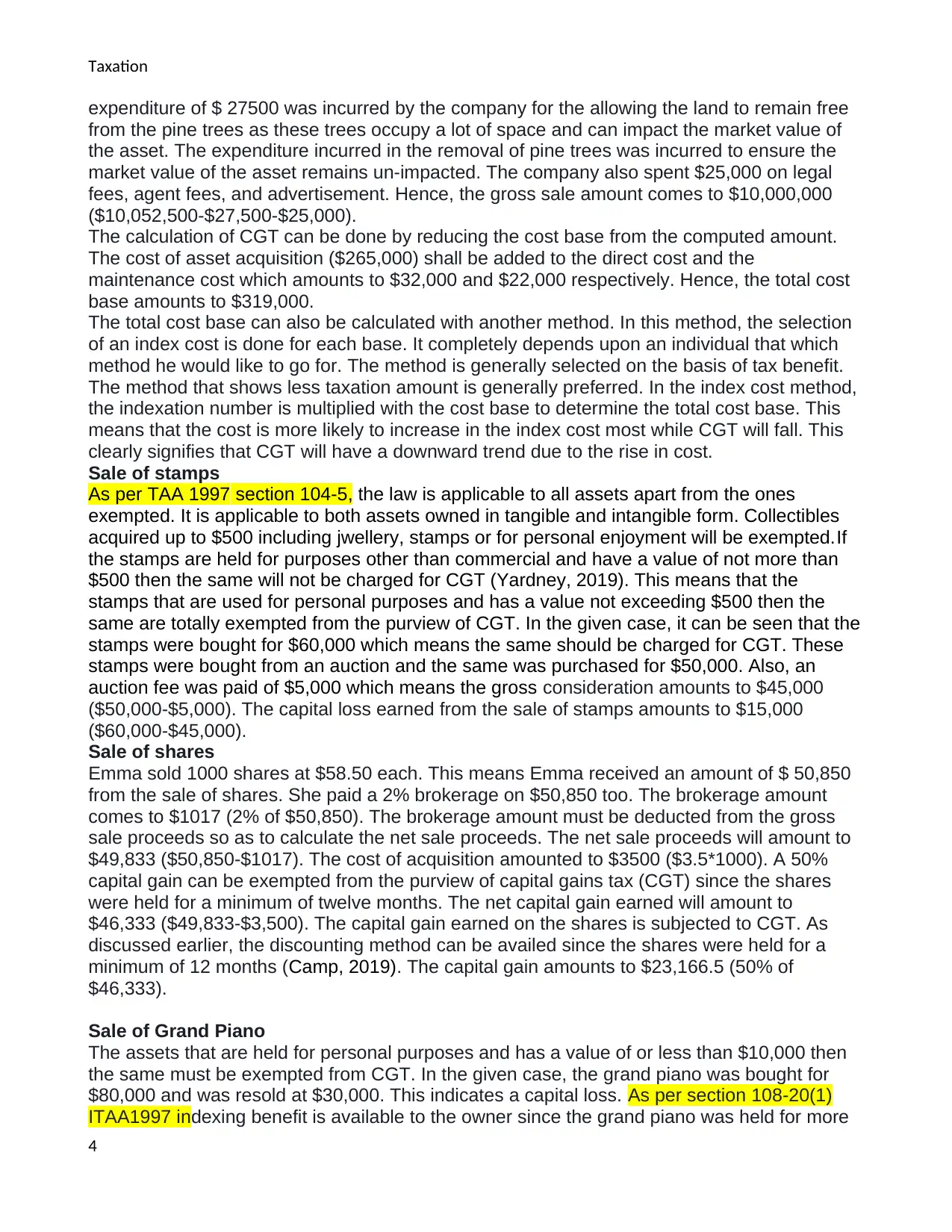
Taxation
expenditure of $ 27500 was incurred by the company for the allowing the land to remain free
from the pine trees as these trees occupy a lot of space and can impact the market value of
the asset. The expenditure incurred in the removal of pine trees was incurred to ensure the
market value of the asset remains un-impacted. The company also spent $25,000 on legal
fees, agent fees, and advertisement. Hence, the gross sale amount comes to $10,000,000
($10,052,500-$27,500-$25,000).
The calculation of CGT can be done by reducing the cost base from the computed amount.
The cost of asset acquisition ($265,000) shall be added to the direct cost and the
maintenance cost which amounts to $32,000 and $22,000 respectively. Hence, the total cost
base amounts to $319,000.
The total cost base can also be calculated with another method. In this method, the selection
of an index cost is done for each base. It completely depends upon an individual that which
method he would like to go for. The method is generally selected on the basis of tax benefit.
The method that shows less taxation amount is generally preferred. In the index cost method,
the indexation number is multiplied with the cost base to determine the total cost base. This
means that the cost is more likely to increase in the index cost most while CGT will fall. This
clearly signifies that CGT will have a downward trend due to the rise in cost.
Sale of stamps
As per TAA 1997 section 104-5, the law is applicable to all assets apart from the ones
exempted. It is applicable to both assets owned in tangible and intangible form. Collectibles
acquired up to $500 including jwellery, stamps or for personal enjoyment will be exempted.If
the stamps are held for purposes other than commercial and have a value of not more than
$500 then the same will not be charged for CGT (Yardney, 2019). This means that the
stamps that are used for personal purposes and has a value not exceeding $500 then the
same are totally exempted from the purview of CGT. In the given case, it can be seen that the
stamps were bought for $60,000 which means the same should be charged for CGT. These
stamps were bought from an auction and the same was purchased for $50,000. Also, an
auction fee was paid of $5,000 which means the gross consideration amounts to $45,000
($50,000-$5,000). The capital loss earned from the sale of stamps amounts to $15,000
($60,000-$45,000).
Sale of shares
Emma sold 1000 shares at $58.50 each. This means Emma received an amount of $ 50,850
from the sale of shares. She paid a 2% brokerage on $50,850 too. The brokerage amount
comes to $1017 (2% of $50,850). The brokerage amount must be deducted from the gross
sale proceeds so as to calculate the net sale proceeds. The net sale proceeds will amount to
$49,833 ($50,850-$1017). The cost of acquisition amounted to $3500 ($3.5*1000). A 50%
capital gain can be exempted from the purview of capital gains tax (CGT) since the shares
were held for a minimum of twelve months. The net capital gain earned will amount to
$46,333 ($49,833-$3,500). The capital gain earned on the shares is subjected to CGT. As
discussed earlier, the discounting method can be availed since the shares were held for a
minimum of 12 months (Camp, 2019). The capital gain amounts to $23,166.5 (50% of
$46,333).
Sale of Grand Piano
The assets that are held for personal purposes and has a value of or less than $10,000 then
the same must be exempted from CGT. In the given case, the grand piano was bought for
$80,000 and was resold at $30,000. This indicates a capital loss. As per section 108-20(1)
ITAA1997 indexing benefit is available to the owner since the grand piano was held for more
4
expenditure of $ 27500 was incurred by the company for the allowing the land to remain free
from the pine trees as these trees occupy a lot of space and can impact the market value of
the asset. The expenditure incurred in the removal of pine trees was incurred to ensure the
market value of the asset remains un-impacted. The company also spent $25,000 on legal
fees, agent fees, and advertisement. Hence, the gross sale amount comes to $10,000,000
($10,052,500-$27,500-$25,000).
The calculation of CGT can be done by reducing the cost base from the computed amount.
The cost of asset acquisition ($265,000) shall be added to the direct cost and the
maintenance cost which amounts to $32,000 and $22,000 respectively. Hence, the total cost
base amounts to $319,000.
The total cost base can also be calculated with another method. In this method, the selection
of an index cost is done for each base. It completely depends upon an individual that which
method he would like to go for. The method is generally selected on the basis of tax benefit.
The method that shows less taxation amount is generally preferred. In the index cost method,
the indexation number is multiplied with the cost base to determine the total cost base. This
means that the cost is more likely to increase in the index cost most while CGT will fall. This
clearly signifies that CGT will have a downward trend due to the rise in cost.
Sale of stamps
As per TAA 1997 section 104-5, the law is applicable to all assets apart from the ones
exempted. It is applicable to both assets owned in tangible and intangible form. Collectibles
acquired up to $500 including jwellery, stamps or for personal enjoyment will be exempted.If
the stamps are held for purposes other than commercial and have a value of not more than
$500 then the same will not be charged for CGT (Yardney, 2019). This means that the
stamps that are used for personal purposes and has a value not exceeding $500 then the
same are totally exempted from the purview of CGT. In the given case, it can be seen that the
stamps were bought for $60,000 which means the same should be charged for CGT. These
stamps were bought from an auction and the same was purchased for $50,000. Also, an
auction fee was paid of $5,000 which means the gross consideration amounts to $45,000
($50,000-$5,000). The capital loss earned from the sale of stamps amounts to $15,000
($60,000-$45,000).
Sale of shares
Emma sold 1000 shares at $58.50 each. This means Emma received an amount of $ 50,850
from the sale of shares. She paid a 2% brokerage on $50,850 too. The brokerage amount
comes to $1017 (2% of $50,850). The brokerage amount must be deducted from the gross
sale proceeds so as to calculate the net sale proceeds. The net sale proceeds will amount to
$49,833 ($50,850-$1017). The cost of acquisition amounted to $3500 ($3.5*1000). A 50%
capital gain can be exempted from the purview of capital gains tax (CGT) since the shares
were held for a minimum of twelve months. The net capital gain earned will amount to
$46,333 ($49,833-$3,500). The capital gain earned on the shares is subjected to CGT. As
discussed earlier, the discounting method can be availed since the shares were held for a
minimum of 12 months (Camp, 2019). The capital gain amounts to $23,166.5 (50% of
$46,333).
Sale of Grand Piano
The assets that are held for personal purposes and has a value of or less than $10,000 then
the same must be exempted from CGT. In the given case, the grand piano was bought for
$80,000 and was resold at $30,000. This indicates a capital loss. As per section 108-20(1)
ITAA1997 indexing benefit is available to the owner since the grand piano was held for more
4
Paraphrase This Document
Need a fresh take? Get an instant paraphrase of this document with our AI Paraphraser
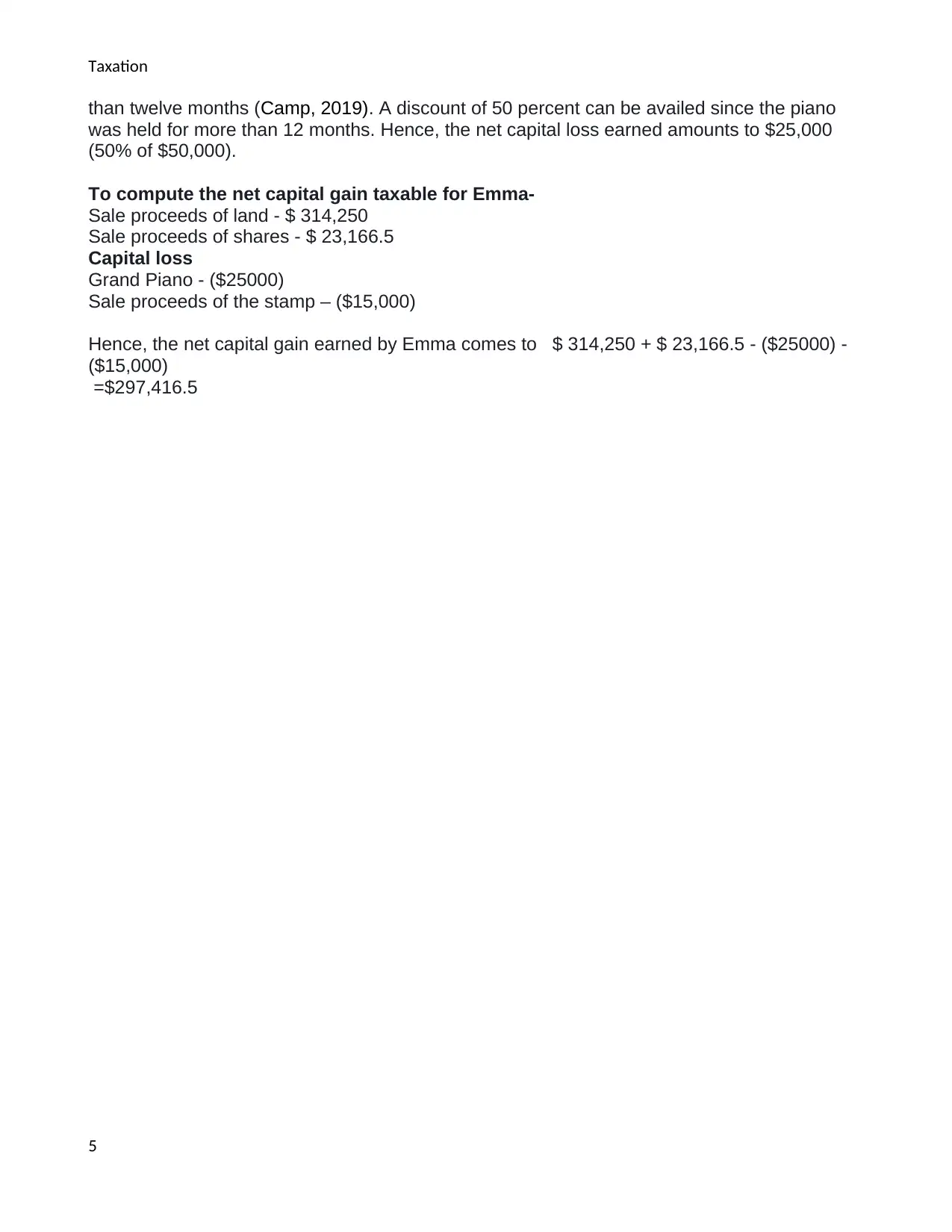
Taxation
than twelve months (Camp, 2019). A discount of 50 percent can be availed since the piano
was held for more than 12 months. Hence, the net capital loss earned amounts to $25,000
(50% of $50,000).
To compute the net capital gain taxable for Emma-
Sale proceeds of land - $ 314,250
Sale proceeds of shares - $ 23,166.5
Capital loss
Grand Piano - ($25000)
Sale proceeds of the stamp – ($15,000)
Hence, the net capital gain earned by Emma comes to $ 314,250 + $ 23,166.5 - ($25000) -
($15,000)
=$297,416.5
5
than twelve months (Camp, 2019). A discount of 50 percent can be availed since the piano
was held for more than 12 months. Hence, the net capital loss earned amounts to $25,000
(50% of $50,000).
To compute the net capital gain taxable for Emma-
Sale proceeds of land - $ 314,250
Sale proceeds of shares - $ 23,166.5
Capital loss
Grand Piano - ($25000)
Sale proceeds of the stamp – ($15,000)
Hence, the net capital gain earned by Emma comes to $ 314,250 + $ 23,166.5 - ($25000) -
($15,000)
=$297,416.5
5
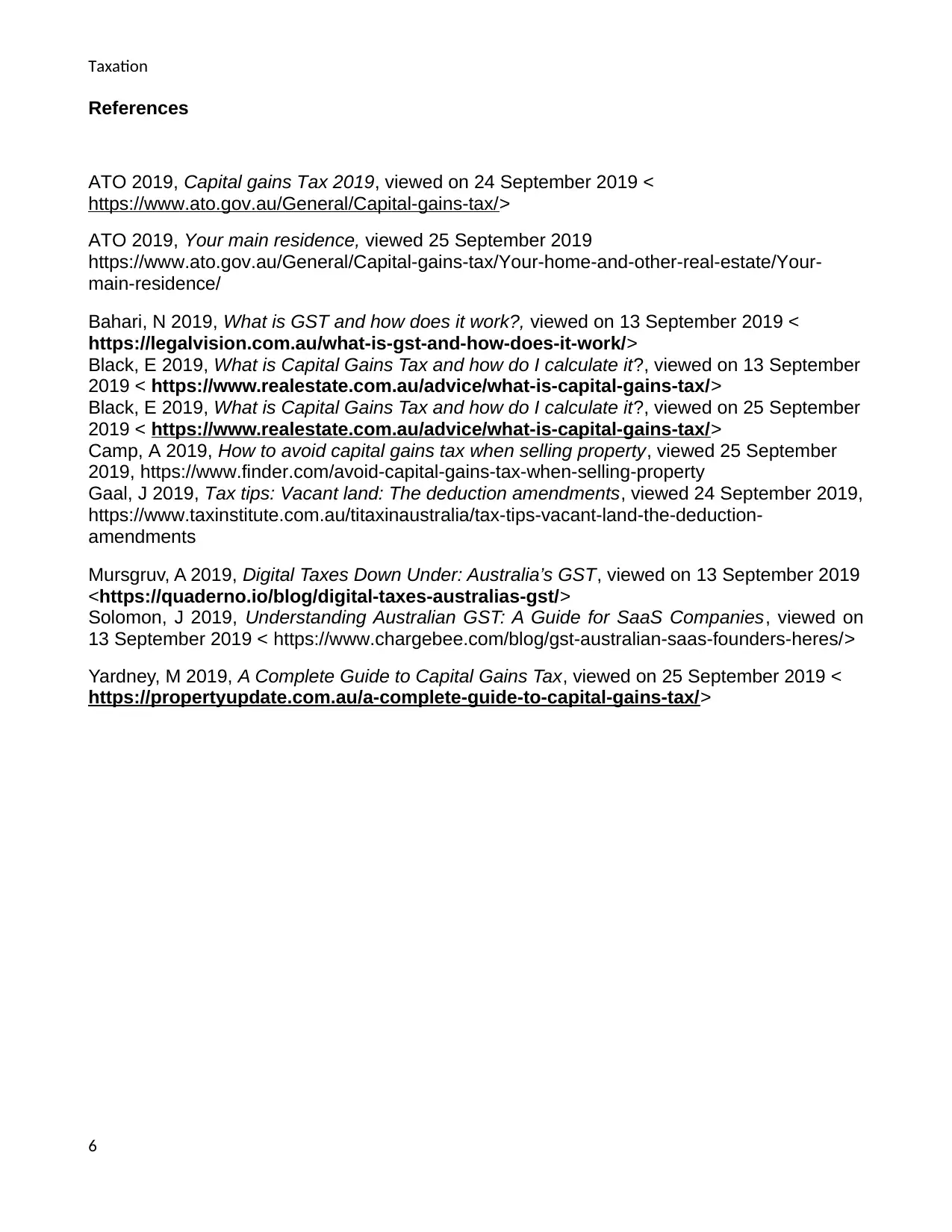
Taxation
References
ATO 2019, Capital gains Tax 2019, viewed on 24 September 2019 <
https://www.ato.gov.au/General/Capital-gains-tax/>
ATO 2019, Your main residence, viewed 25 September 2019
https://www.ato.gov.au/General/Capital-gains-tax/Your-home-and-other-real-estate/Your-
main-residence/
Bahari, N 2019, What is GST and how does it work?, viewed on 13 September 2019 <
https://legalvision.com.au/what-is-gst-and-how-does-it-work/>
Black, E 2019, What is Capital Gains Tax and how do I calculate it?, viewed on 13 September
2019 < https://www.realestate.com.au/advice/what-is-capital-gains-tax/>
Black, E 2019, What is Capital Gains Tax and how do I calculate it?, viewed on 25 September
2019 < https://www.realestate.com.au/advice/what-is-capital-gains-tax/>
Camp, A 2019, How to avoid capital gains tax when selling property, viewed 25 September
2019, https://www.finder.com/avoid-capital-gains-tax-when-selling-property
Gaal, J 2019, Tax tips: Vacant land: The deduction amendments, viewed 24 September 2019,
https://www.taxinstitute.com.au/titaxinaustralia/tax-tips-vacant-land-the-deduction-
amendments
Mursgruv, A 2019, Digital Taxes Down Under: Australia’s GST, viewed on 13 September 2019
<https://quaderno.io/blog/digital-taxes-australias-gst/>
Solomon, J 2019, Understanding Australian GST: A Guide for SaaS Companies, viewed on
13 September 2019 < https://www.chargebee.com/blog/gst-australian-saas-founders-heres/>
Yardney, M 2019, A Complete Guide to Capital Gains Tax, viewed on 25 September 2019 <
https://propertyupdate.com.au/a-complete-guide-to-capital-gains-tax/>
6
References
ATO 2019, Capital gains Tax 2019, viewed on 24 September 2019 <
https://www.ato.gov.au/General/Capital-gains-tax/>
ATO 2019, Your main residence, viewed 25 September 2019
https://www.ato.gov.au/General/Capital-gains-tax/Your-home-and-other-real-estate/Your-
main-residence/
Bahari, N 2019, What is GST and how does it work?, viewed on 13 September 2019 <
https://legalvision.com.au/what-is-gst-and-how-does-it-work/>
Black, E 2019, What is Capital Gains Tax and how do I calculate it?, viewed on 13 September
2019 < https://www.realestate.com.au/advice/what-is-capital-gains-tax/>
Black, E 2019, What is Capital Gains Tax and how do I calculate it?, viewed on 25 September
2019 < https://www.realestate.com.au/advice/what-is-capital-gains-tax/>
Camp, A 2019, How to avoid capital gains tax when selling property, viewed 25 September
2019, https://www.finder.com/avoid-capital-gains-tax-when-selling-property
Gaal, J 2019, Tax tips: Vacant land: The deduction amendments, viewed 24 September 2019,
https://www.taxinstitute.com.au/titaxinaustralia/tax-tips-vacant-land-the-deduction-
amendments
Mursgruv, A 2019, Digital Taxes Down Under: Australia’s GST, viewed on 13 September 2019
<https://quaderno.io/blog/digital-taxes-australias-gst/>
Solomon, J 2019, Understanding Australian GST: A Guide for SaaS Companies, viewed on
13 September 2019 < https://www.chargebee.com/blog/gst-australian-saas-founders-heres/>
Yardney, M 2019, A Complete Guide to Capital Gains Tax, viewed on 25 September 2019 <
https://propertyupdate.com.au/a-complete-guide-to-capital-gains-tax/>
6
⊘ This is a preview!⊘
Do you want full access?
Subscribe today to unlock all pages.

Trusted by 1+ million students worldwide
1 out of 6
Related Documents
Your All-in-One AI-Powered Toolkit for Academic Success.
+13062052269
info@desklib.com
Available 24*7 on WhatsApp / Email
![[object Object]](/_next/static/media/star-bottom.7253800d.svg)
Unlock your academic potential
Copyright © 2020–2025 A2Z Services. All Rights Reserved. Developed and managed by ZUCOL.





